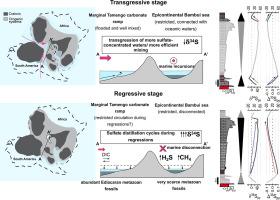当前位置:
X-MOL 学术
›
Gondwana Res.
›
论文详情
Our official English website, www.x-mol.net, welcomes your feedback! (Note: you will need to create a separate account there.)
Multiple sulfur isotopes and stratigraphic constraints for the 34S enrichments in the late Ediacaran-Cambrian pyrite-sulfur record: A product of supercontinent assembly and restricted seas
Gondwana Research ( IF 6.1 ) Pub Date : 2024-03-14 , DOI: 10.1016/j.gr.2024.03.004 Sergio Caetano-Filho , Pierre Sansjofre , Gustavo M. Paula-Santos , Magali Ader , Pierre Cartigny , Cristian Guacaneme , Marly Babinski , Matheus Kuchenbecker , Humberto L.S. Reis , Ricardo I.F. Trindade
Gondwana Research ( IF 6.1 ) Pub Date : 2024-03-14 , DOI: 10.1016/j.gr.2024.03.004 Sergio Caetano-Filho , Pierre Sansjofre , Gustavo M. Paula-Santos , Magali Ader , Pierre Cartigny , Cristian Guacaneme , Marly Babinski , Matheus Kuchenbecker , Humberto L.S. Reis , Ricardo I.F. Trindade

|
The late Ediacaran record encompasses frequent occurrences of S-enriched pyrites, which can surpass the coexisting sulfate isotope values. Deciphering what controls this marine isotope record is important to understand its biogeochemical implications, especially considering the early metazoan evolution. We present here multiple sulfur isotope compositions from pyrites of two distinct geotectonic settings within the late Ediacaran-early Cambrian West Gondwana, allowing to constraint spatial and temporal distribution of S-enrichments. The Tamengo Formation represents a carbonate-siliciclastic ramp at Gondwana’s continental margin, whereas the Bambuí Group records an epeiric sea within the core of this supercontinent. Both units display positive δS excursions matching regressive trends (δS up to 51 ‰), with a drop in δS values associated with transgressions. A scenario of sulfate-distillation events throughout regressions is supported by the multiple sulfur isotope data, after transgressive events that episodically recharged sulfate in these environments. However, in the epicontinental Bambuí sea, δS ΔS and ΔS values suggest almost quantitative conversion of the initial sulfate into sulfide at the end of regressive stage, forced by enhanced stratification and inefficient circulation within continental areas. In this case, widespread toxic euxinic conditions were developed in inland seas, accompanied by methanogenesis, which resulted in highly C-enriched DIC due to methanogenic CO, as recorded in the Bambuí Group. In the Tamengo ramp, on the other hand, sulfate levels would have not been completely consumed due to more frequent and efficient mixing with open waters, preventing perturbations in the carbon cycling and representing more favorable conditions to metazoan colonization, considering the abundant metazoan fossil record in this unit. The studied basins illustrate how 1-order tectonic cycles may have been the major player over remarkable S-enrichments in pyrite for specific time intervals of the sedimentary record, through supercontinent assembly and expansion of restricted settings more prone to sulfate distillation.
中文翻译:

埃迪卡拉晚期-寒武纪黄铁矿硫记录中34S富集的多种硫同位素和地层限制:超大陆组装和限制海的产物
埃迪卡拉晚期记录包括频繁出现的富硫黄铁矿,其含量可能超过共存的硫酸盐同位素值。破译控制这种海洋同位素记录的因素对于理解其生物地球化学意义非常重要,特别是考虑到早期后生动物的进化。我们在这里展示了来自埃迪卡拉晚期-寒武纪早期西冈瓦纳两种不同大地构造背景的黄铁矿的多种硫同位素组成,从而限制了硫富集的空间和时间分布。塔门戈组(Tamengo Formation)代表了冈瓦纳大陆边缘的碳酸盐-硅质碎屑坡道,而班布伊群(Bambuí Group)则记录了该超大陆核心内的陆海。两个单位都显示出与回归趋势相匹配的正 δS 偏移(δS 高达 51 ‰),并且与海侵相关的 δS 值下降。在这些环境中不定期地补给硫酸盐的海侵事件之后,多种硫同位素数据支持了整个回归过程中硫酸盐蒸馏事件的情景。然而,在陆表 Bambuí 海中,δS ΔS 和 ΔS 值表明,在海退阶段末期,由于大陆区域内分层增强和低效环流,初始硫酸盐几乎定量地转化为硫化物。在这种情况下,内陆海域出现了广泛的有毒环境,并伴随着产甲烷作用,从而导致了由于产甲烷CO而导致高度富含C的DIC,如Bambuí群的记录。另一方面,在塔门戈坡道,考虑到丰富的后生动物化石记录,由于更频繁和更有效地与开放水域混合,硫酸盐水平不会完全消耗,防止碳循环的扰动,并为后生动物的殖民提供更有利的条件在这个单位。研究的盆地说明,通过超大陆的组装和更容易发生硫酸盐蒸馏的受限环境的扩展,一阶构造旋回可能是沉积记录的特定时间间隔内黄铁矿显着富硫的主要因素。
更新日期:2024-03-14
中文翻译:

埃迪卡拉晚期-寒武纪黄铁矿硫记录中34S富集的多种硫同位素和地层限制:超大陆组装和限制海的产物
埃迪卡拉晚期记录包括频繁出现的富硫黄铁矿,其含量可能超过共存的硫酸盐同位素值。破译控制这种海洋同位素记录的因素对于理解其生物地球化学意义非常重要,特别是考虑到早期后生动物的进化。我们在这里展示了来自埃迪卡拉晚期-寒武纪早期西冈瓦纳两种不同大地构造背景的黄铁矿的多种硫同位素组成,从而限制了硫富集的空间和时间分布。塔门戈组(Tamengo Formation)代表了冈瓦纳大陆边缘的碳酸盐-硅质碎屑坡道,而班布伊群(Bambuí Group)则记录了该超大陆核心内的陆海。两个单位都显示出与回归趋势相匹配的正 δS 偏移(δS 高达 51 ‰),并且与海侵相关的 δS 值下降。在这些环境中不定期地补给硫酸盐的海侵事件之后,多种硫同位素数据支持了整个回归过程中硫酸盐蒸馏事件的情景。然而,在陆表 Bambuí 海中,δS ΔS 和 ΔS 值表明,在海退阶段末期,由于大陆区域内分层增强和低效环流,初始硫酸盐几乎定量地转化为硫化物。在这种情况下,内陆海域出现了广泛的有毒环境,并伴随着产甲烷作用,从而导致了由于产甲烷CO而导致高度富含C的DIC,如Bambuí群的记录。另一方面,在塔门戈坡道,考虑到丰富的后生动物化石记录,由于更频繁和更有效地与开放水域混合,硫酸盐水平不会完全消耗,防止碳循环的扰动,并为后生动物的殖民提供更有利的条件在这个单位。研究的盆地说明,通过超大陆的组装和更容易发生硫酸盐蒸馏的受限环境的扩展,一阶构造旋回可能是沉积记录的特定时间间隔内黄铁矿显着富硫的主要因素。



























 京公网安备 11010802027423号
京公网安备 11010802027423号